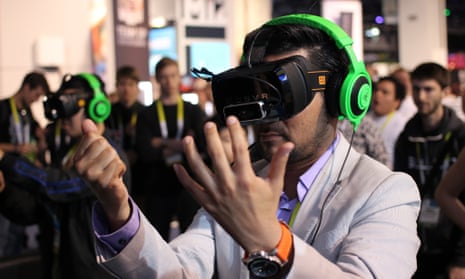Twenty years almost to the day, on 6 January 1995, Nintendo revealed its new Virtual Boy virtual reality headset at the Consumer Electronics Show in Las Vegas. Technologists had been experimenting with virtual reality since the 1960s, but the headset was a significant milestone by the then thriving Japanese games company. The press were unwilling to write off anything by Nintendo, but VR aficionados were not convinced. And as it turns out, they were right: players complained of dizziness, nausea and headaches and Nintendo sold only 770,000 – a tenth of predicted sales. The device was canned.
“When Virtual Boy was introduced there was a lot of excitement about virtual reality and augmented reality as part of the future of gaming, but it didn’t happen that way for a variety of reasons,” said Regina Joseph, a forecasting expert and lead at New York University’s Future Lab. “The technology simply wasn’t at the same level as it is now, and there were some fundamental ergonomic issues. The hype concentrated in the press, and in a press run by fanboys, often doesn’t pan out. History is littered with the corpses of devices, projects and ideas that people got behind in a big way but that failed.”

The vast CES event has long been regarded as the essential showcase for all the world’s new technology products. It’s the most comprehensive gathering of technology companies and devices on the planet, with 170,000 delegates and 2.2m square feet of exhibits showing off everything from fridges and robots to drones and new TVs. From here, one can traditionally see right through to next Christmas – and beyond.
All eyes this year are, again, on virtual reality, which appears to be heading toward the mainstream with three major consumer headsets – the HTC Vive, Oculus Rift and Sony’s Playstation VR - all due for release this year. How to define the success of those devices? There is financial momentum, and the support of major investors such as Facebook in Oculus; consumer interest, which will show in the sales numbers of these devices later in the year; but also the creativity of software developers, because without compelling games and experiences, VR has no stories to tell. Joseph says: “VR still needs a lot more software - those are the pivotal catalysts for these devices.”
Are autonomous cars ready to take off?
Also centre stage will be autonomous and electric cars. Car manufacturers have, in recent years, used CES to show off their progress with autonomous vehicle software, and new prototypes will be unveiled from Faraday Future, VW and Chevy, a slew of new developments from the major car firms and also the likely confirmation of a joint initiative between Ford and Google on a new mainstream self-driving car initiative. Google has said that it is in talks with car manufacturers, and that it expects to see 10 million autonomous vehicles on the road by 2020.
Joseph is sceptical about the pace of adoption for electric and autonomous vehicles, which demand more of a leap in consumer faith, and said that Google’s prediction is too ambitious. “The US is a country built on cars and oil. Driving is cultural and there’s a profoundly held experiential feeling attached to it. Appeals to culture are extraordinarily difficult, whether politically or to consumers, because you are dealing with the world of moral values,” says Joseph. “Advertising is in the business of shaping moral values and consumer attitudes, but when they do a product launch they have to soften the ground for years before introducing something controversial. There needs to be a cultural conversion.”
She points to the relatively slow adoption of mobile phones, which took ten years to progress from the size of a brick to a flip phone. “Ten years. And mobile phones are far more accessible from a safety perspective than cars. Introducing autonomous vehicles into rolling stock of driver-led cars? It will take 20 years, not five.”
Kickstarter’s barometer of emerging tech trends
Beyond the major brands, CES has expanded to provide a platform for startups and inventors. The crowd-funding platform Kickstarter has seen CES’s entrepreneurial space Eureka Park grow significantly in the past four years. “Before that we were in the dungeons,” jokes John Dimatos, director of Kickstarter’s design and technology communities, many of whom will be exhibiting at the show. “CES is a family moment for us. If you go to see the big brands here you’ll be talking to someone in marketing, but when you walk up to a Kickstarter team you’re talking to the engineer. Everybody is learning from everybody else - it’s an exciting time to be doing hardware and consumer electronics.”
At CES 2015, a small French team called Prynt hadn’t yet launched the crowdfunding campaign to fund their device, a small camera and instant printer which attaches to a smartphone. One year on and their first device is already on sale. Another popular Kickstarter project has been Chip, an Oakland based team that has developed a $9 mini computer designed to be used as a component to power other projects. Dimatos says: “It adds up to something like the Homebrew Computing Club [the hobbyist club attended by a young Steve Jobs and Steve Wozniak in the late 1970s] but this is more visible and public.”
Kickstarter’s overview of the thousands of projects proposed each year, and the varying popularity of different hardware and software, means it is well placed to identify new trends. Better placed, maybe, than CES. Of the 19,802 technology projects launched on the site so far, 3,887 have been successfully funded by the public, from drones and 3D printers to a wired air guitar and headphones. The now ubiquitous (and controversial) hoverboards started on Kickstarter with a project called Hovertrax which was first funded in May 2013. Dimatos says that was just one of a wave of “last mile of transportation” projects on Kickstarter, and though many start as curios they occasionally break out, as the hoverboard did. (Battery powered rollerskates have yet to break free in quite the same way.)

2015 saw a big increase in food technology projects and the trend, says Dimatos, and is set to grow. Livin is a hive for growing edible mealworms in your kitchen, designed to provide a more sustainable form of protein that avoids the intensive farming industry. Grove is an aquaponic system where waste from a fish tank supports the growth of herbs and vegetables.
Another strong trend is battery technology, which may not seem as exciting but is a critical technology for almost every consumer electronics device. The Orison project, soon to be on Kickstarter, is an energy efficient storage device that allows energy saved during the day to be used at night.
Joseph says that beyond the hyped products of CES, the seemingly mundane nuts and bolts of component technology can be one of the most revealing predictors of trends to come. The technology behind flexible, energy-efficient and high quality OLED screens (organic light-emitting diodes) have facilitated many new devices, enabling good quality products at affordable prices.
Consumer adoption is more about psychology than technology
But with so much money ploughed into marketing spectaculars at CES, how much does the event really indicate future trends? Is it really a reliable indicator - or just a platform for generating hype and sales?
Bob Sawyer, an investment manager, says that the industry experts and market analysts that flock to CES are not necessarily the best at predicting trends. “They know too much, or have conflict of interest,” he says. “Mobile experts have been saying for 20 years that mobile payments are just around the corner - but most experts are in mobile payments businesses.” Given the popularity of plastic and, in the US, paper checks, there needs to be a tipping point for those services to take off.
Sawyer says society tends to overestimate short-term change while underestimating long-term change. Forecasters in the 40s and 50s, he said, made impressively accurate predictions about medical breakthroughs, yet completely missed the internet.
“Most people at CES want to hear that their product will be a slam dunk hit and be under everyone’s Christmas trees this time next year. But the culture of consumer behaviour and adoption means it’s much less about the technology and more about psychology and economics.”

Comments (…)
Sign in or create your Guardian account to join the discussion